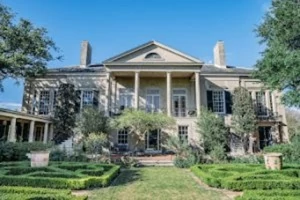Longue Vue House & Gardens

The Longue Vue house you see today was the second home built for the Stern family on this site. The first house was moved (it still stands at the intersection of Garden Lane and Metairie Road, about 100 yards away) to make room for the current, starkly different home. A crew of donkeys spent several weeks pulling the house on logs, just a short way each day. How this odd scene came about is as surprising as the move itself: Having built what they thought was their dream home in 1921, Edith and Edgar Stern later became convinced that this first house did not live up to the splendid gardens emerging around it, through the talents of landscape architecture visionary Ellen Biddle Shipman. While traveling through Europe and Africa in 1936 and 1937, the Sterns were struck by many house-and-garden sites they visited and came home eager to create their own, more integrated indoor-outdoor design. Edith and Edgar first approached Shipman, at the time serving exclusively as their landscape architect, about designing the new house as well. Shipman had no experience in built architecture, however, and recommended architects William and Geoffrey Platt, the sons of her mentor. The Sterns agreed, especially once Shipman consented to do the interior design. Between their fascination with European estates and their interest in local architecture, the Sterns were undecided on the final character they wanted for the exterior of their new home, so the Platts designed four different façades. As a result, each side of the house can be considered a ‘front’ and allows the ability to enter and exit. The west-facing façade, overlooking Oak Allee, is inspired by symmetrical Palladian design, with identical flanking dependencies and colonnades. The south-facing façade, overlooking the Spanish Court, is based on the Beauregard-Keyes House in the French Quarter. The east-facing façade, overlooking the East Lawn, was inspired by Shadows-on-the-Teche in New Iberia, Louisiana, complete with a faux-shutter wall alluding to that home’s famed porches. The north-facing façade, overlooking the tennis court, is a Georgian classic revival with an added fire escape. Though the home was designed to appear timeless, the second Longue Vue house was a 20th-century state-of-the-art engineering marvel. A residential central air conditioning system – unknown in the region at that time – allowed flexibility in ceiling height and room scale. The Platt brothers took advantage of this flexibility to customize the experience of each room, much as Shipman was able to curate a different experience in each garden space. To accommodate the air system, as well as Edgar’s love of gadgets (including a house-wide clock system), photography dark room, and wine cellar, the home has a large below-grade basement, unique in our low-lying area. The style of the house extended to supporting structures, creating a sense of grandeur but also coherent functionality that reflects the Stern’s love of both the luxurious and the practical. Along with the colors, sounds, and scents of the gardens, the presence of these thoughtful built structures punctuating the Longue Vue grounds is an important part of the Longue Vue experience today.
Listed in:
- Entertainment & Activities: Museums & Tours



